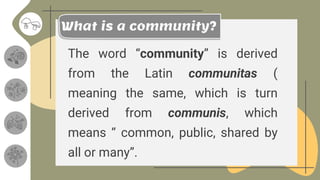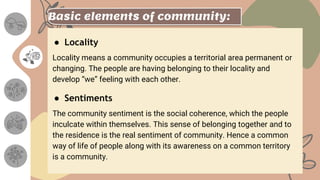Characteristics of community
- 2. The word “community” is derived from the Latin communitas ( meaning the same, which is turn derived from communis, which means “ common, public, shared by all or many”. What is a community?
- 3. ● A community is a group of people living in the same place or having a particular characteristic in common such as norms, religion, values or identity. ● It is also a place where individuals work and play.
- 4. Basic elements of community: ● Locality Locality means a community occupies a territorial area permanent or changing. The people are having belonging to their locality and develop “we” feeling with each other. ● Sentiments The community sentiment is the social coherence, which the people inculcate within themselves. This sense of belonging together and to the residence is the real sentiment of community. Hence a common way of life of people along with its awareness on a common territory is a community.
- 5. ● Group of People Community is the totality of individuals with similar conditions of life. Thus it is a group of a people living together similarly. ● Common Life One of the elements of community is that there is always common life. There is no up and downs and inequality in community. ● Particular Name A community is always identified by its name. Thus it has its own particular name.
- 6. ● Production, Distribution, Consumption The community provides its members with the means of their living. This may be agriculture, industry or services. ● Socialization The community has means by which it instills its norms and values in its members. This may be tradition, modeling and/or formal education. Five functions of community:
- 7. ● Social Control The community has the means to enforce adherence to community values. This may be group pressure to conform and/or formal laws. ● Social Participation The community fulfills the need for companionship. This may occur in a neighborhood church, business or other group.
- 8. ● Mutual Support The community enables its members to cooperate to accomplish tasks too large or too urgent to be handled by a single person. Supporting a community hospitals with tax dollars and donations is an example of people cooperating to accomplish the task health care.
- 9. 1. Distinctiveness 2. Homogeneity Each community has defined geographical boundaries having its beginning and end. These boundaries are more demarkable in smaller communities than in larger communities. E.g: village, town, neighborhood etc. There is similarity in psychosocial characteristics of people living in the defined boundaries of the community. Similarity in language, life style, customs, interest, traditions etc. Characteristics of Community:
- 10. 3. Closeness 4. Self-sufficiency The people in the community have to face to face interaction and free communication. E.g. mostly in small communities like small village and neighborhood. The community provides all such means and facilities which help in meeting the basic needs of its people. The space to live, means for livelihood, education, protection and security. Characteristics of Community:
- 11. 5. Solidarity or sense of togetherness There is unity and cohesiveness among the members in the community which is based on their interaction and sense of belongingness to community. Characteristics of Community:
- 12. Two types of community: URBAN An urban area is the region surrounding a city. Most inhabitants of urban areas have non agricultural jobs. Urban areas are very developed, meaning there is a density of human structures such as houses, commercial buildings, roads, bridges, and railways. RURAL Rural areas are the opposite of urban areas. Rural areas, often called "the country," have low population density and large amounts of undeveloped land.
- 13. RURAL URBAN ● Source of income is from primary sector activities like agriculture and fishing. ● Source of income is from secondary sector activities including industries or factories or services. ● They have all the basic necessities and advanced medical services. ● People usually produce their own food for subsistence. ● People visit fresh markets and grocery stores to buy food. ● They have the basic necessities but these areas do not have the medical services for which they have to go to the cities. ● They consist of a small population. ● They consist of a very high population. ● Both have an education system. ● Both have jobless and poor people. ● Both types of community have hospitals, police officers and firemen that provide services to community.
- 14. THANK YOU!













